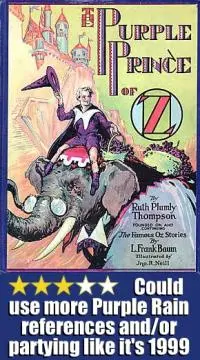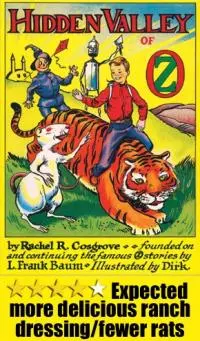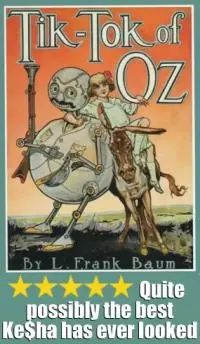"The land you know. The story you don't." That's the tagline to Disney's $200 million Wizard Of Oz prequel, Oz: The Great And Powerful, which hits U.S. theaters today. But do you really know the Land of Oz? Sure, you've seen the 1939 classic starring Judy Garland. It is, after all, not just an inextricable part of pop culture but also one of the most watched films of all time. You might even have spent a trippy night carefully lining up Pink Floyd's Dark Side Of The Moon with the roar of the MGM lion; gone to see Wicked on Broadway; read the L. Frank Baum book that the movie is based on; and seen the 1978 Motown version, The Wiz, featuring Diana Ross and Michael Jackson. Even if you've done all of this, you're still a mere tourist in that mysterious world because the story of Oz is more extensive than most of us could imagine. We're talking forty-two officially recognized books worth of extensive. Never mind the countless unsanctioned alternate versions, prequels, and sequels. So before we head to the theater tonight, let's take a quick look at some of the stories, characters, and places most of us never knew existed beyond the rainbow.
Not In Kansas Anymore
 The story most of us are familiar with is based on L. Frank Baum's first Oz book, The Wonderful Wizard Of Oz. Illustrated by W.W. Denslow, who shared the copyright, it was the nation's best-selling children's book for two years and sold more than five million copies before its copyright expired in 1956. (All of Baum's Oz books are in the public domain now, so go nuts writing a stage version featuring turtles and hand puppets or fan fiction that replaces Dorothy with a sluttier version of Agent Scully.) Those might seem like meager sales numbers in today's 100-million-plus-sold world of Twilight and Fifty Shades, but Oz's sales figures were nothing to scoff at in the early 1900s. It was, essentially, the Harry Potter of its time.
The story most of us are familiar with is based on L. Frank Baum's first Oz book, The Wonderful Wizard Of Oz. Illustrated by W.W. Denslow, who shared the copyright, it was the nation's best-selling children's book for two years and sold more than five million copies before its copyright expired in 1956. (All of Baum's Oz books are in the public domain now, so go nuts writing a stage version featuring turtles and hand puppets or fan fiction that replaces Dorothy with a sluttier version of Agent Scully.) Those might seem like meager sales numbers in today's 100-million-plus-sold world of Twilight and Fifty Shades, but Oz's sales figures were nothing to scoff at in the early 1900s. It was, essentially, the Harry Potter of its time.
As an inspirational aside to struggling writers who don't happen to be 22-year-old wunderkind: Note that Baum—who ultimately gave us one of the most beloved stories of all time—wrote his first book (let's not count the instructional volume on chicken rearing he put out when he was 30), at the age of forty-one. This after years spent raising fancy chickens, starting a poultry journal, running a variety store, selling fireworks, and editing a magazine about department store window displays. The first of his fourteen Oz books was published when he was 44. Baum wrote a total of fifty-five novels (fourteen Oz-related and the rest less-successful fantasy and fairy tales), more than eighty short stories (including six Little Wizard Stories Of Oz for younger readers), and an untold number of stage plays, poems, and odd tomes about stamp dealing, poultry, and decorating windows. It's never too late to chase the dream.
The Oz You Think You Know
Okay, so at least we've all got the first book down then, right? Not so fast... even that, the most familiar of the Oz series, will surprise you if you haven't read it. There's been some complaining online (hard to believe, I know) that the new film version can't use some of the iconic imagery from the film due to copyright issues. There will be, for example, no mention of ruby slippers in the 2013 Sam Raimi-directed blockbuster. That just ruins everything. It's not The Wizard Of Oz without ruby slippers. Outrage! Except there were no ruby slippers in the original book. Dorothy's magic shoes were silver, and she lost them in a desert. They were changed to the dazzling red footwear that we know to take advantage of the fancy Technicolor technology used in the movie. There's widespread speculation that the book was, in fact, an allegory on the political and economic climate of the 1890s and that Dorothy's silver shoes were part of a populist parable.
As is typical with movie adaptations, the 1939 film differs from its source material in more ways than I can list here—at least without losing your attention. A few of the notable differences, besides the ruby slippers: In the book, Oz is a real place, not a dream world; thus the existence of forty-one sequels. The Wicked Witch Of The West is a blip on the radar rather than the primary obstacle. Dorothy is a stronger, more feminist protagonist and considerably less weepy. There are quite a few more subplots, including a visit to a city made of China and an encounter with an odd race of armless guards called Hammerhead, and much, much more beheading.
The Royal Historians Of Oz
 Baum, self-proclaimed Royal Historian Of Oz, presented Oz as an actual land whose history was being relayed to him by visitors and residents of Oz. When he wanted to put an end to the series after the sixth book, The Emerald City Of Oz, he claimed to have difficulty reaching Dorothy. When his other non-Oz books failed to pay the bills, Dorothy conveniently got in touch via a telegraph message so that Baum could continue the saga. Following Baum's death in 1919, eight other officially sanctioned authors have contributed to the series as Royal Historians Of Oz. Together, the nine authors have invented a meticulously detailed world complete with a flag, maps, economic and political background, and defense strategy. For the three of you who want to delve into the minutia of that and argue the merits of one author's interpretation over another or the inaccuracies present in various obscure non-canonical versions, I direct you to the fantasy worlds track at Comic-Con or Dragon*Con, where you can also throw a twelve-sided die at anyone who dares disagree with you. For the rest of you, head to Wikipedia or, better yet, get crackin' on the book series.
Baum, self-proclaimed Royal Historian Of Oz, presented Oz as an actual land whose history was being relayed to him by visitors and residents of Oz. When he wanted to put an end to the series after the sixth book, The Emerald City Of Oz, he claimed to have difficulty reaching Dorothy. When his other non-Oz books failed to pay the bills, Dorothy conveniently got in touch via a telegraph message so that Baum could continue the saga. Following Baum's death in 1919, eight other officially sanctioned authors have contributed to the series as Royal Historians Of Oz. Together, the nine authors have invented a meticulously detailed world complete with a flag, maps, economic and political background, and defense strategy. For the three of you who want to delve into the minutia of that and argue the merits of one author's interpretation over another or the inaccuracies present in various obscure non-canonical versions, I direct you to the fantasy worlds track at Comic-Con or Dragon*Con, where you can also throw a twelve-sided die at anyone who dares disagree with you. For the rest of you, head to Wikipedia or, better yet, get crackin' on the book series.
Baum's fourteenth and final book, Glinda Of Oz, was published posthumously in 1920 at which point Philadelphia-based children's author Ruth Plumly Thompson took over the series, writing one book every year from 1921 to 1939, making her contribution to the series the most extensive of any Royal Historian, including Baum himself. Her take on Oz tended to be more humorous and kid-friendly than Baum's, who had a tendency to let things get a little dark at times. (In Baum's Tin Woodman Of Oz, for example, the Tinman is cursed to amputate his own limbs with his axe. That last arm must have been tough.) Thompson anthropomorphized the heck out of everything—talking scrolls, a balloon dude named Atmos Fere (so clever), Bill the iron weathercock, and Humpy the stunt dummy Dorothy meets in Hollywood. I am not making this up.
The next Royal Historian Of Oz was also known as the Royal Painter Of Oz, and was, by many accounts, a better artist than writer. John R. Neill took over writing duties after Thompson, but had already been a vital part of the Oz series for nearly forty years. Baum had a falling out with the first book's illustrator, so save for The Wonderful Wizard Of Oz, Neill illustrated all thirty-three of Baum and Thompson's novels as well as the three Oz novels he wrote himself between 1940 and 1942. Each of the thirty-five books featured more than a hundred pen-and-ink drawings by Neill, who has also been called the Imperial Illustrator Of Oz. These folks love to give each other titles.
Neill was succeeded by Jack Snow, who wrote two Oz books in 1946 and 1951. Snow was a long-time Oz scholar who originally offered to take over the series after Baum died in 1919, but was turned down on account of the fact that he was 12 years old at the time. Nice try, kiddo.
Next, Rachel Cosgrove Payes wrote two Oz books—one was published in 1951 and is considered among the "Famous Forty" books of Oz; the other was rejected by long-time Oz publisher Reilly & Lee when it was decided Oz books were out of fashion. Her second book was not published until The International Wizard Of Oz Club picked it up in 1993. The last of the Famous Forty is Merry Go Round In Oz, written in 1963 by Eloise Jarvis McGraw and Lauren Lynn McGraw.
Beyond The Famous Forty
 The story of Oz and its wacky citizens is seemingly endless. It continues even today with current Royal Historian Sherwood Smith, who, in 2005, penned The Emerald Wand Of Oz, the first officially sanctioned book in more than four decades. Endorsed by Baum's family, Smith wrote Trouble Under Oz in 2006 and is reportedly at work on Sky Pirates Of Oz right now. Sky pirates, you guys! It never ends.
The story of Oz and its wacky citizens is seemingly endless. It continues even today with current Royal Historian Sherwood Smith, who, in 2005, penned The Emerald Wand Of Oz, the first officially sanctioned book in more than four decades. Endorsed by Baum's family, Smith wrote Trouble Under Oz in 2006 and is reportedly at work on Sky Pirates Of Oz right now. Sky pirates, you guys! It never ends.
There are also dozens of unofficial Oz books by authors who either went rogue and did their own versions of Oz or fans who tried to closely adhere to the history and geography of the Oz created in the canonical books. A few notable examples: Baum's son, Frank Joslyn Baum, was slapped with a lawsuit after his The Laughing Dragon Of Oz was published by a competing publisher in 1934.
In 1939, as the movie version of Oz was becoming hot in the States, a Russian named Alexander Melentyevich Volkov translated Baum's original Wonderful Wizard Of Oz, added a few chapters, changed Dorothy's name to Ellie and Oz's name to Magic Land, and released the book, The Wizard Of The Emerald City, as his own with no royalties to Baum. Seems legit, no? Still, it was a big hit with Eastern Bloc kids. He went on to write (actually write) five sequels in the sixties and seventies. There are places in the world where Volkov's version of Oz is better known than Baum's. Granted, those same places still think t.A.T.u. is one of the greatest bands to have ever lived.
The revisionist history written in the four-book Wicked Years series by Gregory Maguire spawned the 2003 Tony-winning Broadway musical Wicked and, aside from the mega-budget Disney version of Oz being released today, did more to bring Baum's fantastical land back to the forefront of pop culture than anything in recent years. Except maybe the Muppets' 2005 version of Oz because who can resist a Tin Thing Gonzo in what appears to be some kind of metal BDSM outfit?
15 Quick And Wonderful Reasons You (Or Your Kids) Should Explore Oz
Forty-two books seems like a commitment—and it is—but the sheer amount of imagination packed into its pages makes the Oz series well worth your (or your child's) time. Besides, it's still 358 books shorter than the Sweet Valley High series, 133 books shorter than Nancy Drew, and 293 books shorter than The Babysitters Club. Here are but a few of the wondrous and bizarre places and characters you'll run across during your exploration of Oz.
- Pigasus, a magical flying pig who compels his riders to speak only in rhyming jingles, like a whimsical version of an Oscar Mayer ad.
- An honest and industrious goat-girl named Mandy, because dishonest, lazy goat-girls are not worth your time.
- Dragons, mermaids, pirates, gnomes, fairies, witches, imps, gargoyles, unicorns, and pretty much any other mythological race you could call to mind.
- The Bun People of Bunbury, a portly race of pastry-people led by one Mr. Cinnamon Bunn, whose butter is on the inside to minimize mess.
- A city of civilized bunnies who dress like dandies and hate outsiders.
- Dainty China Country, which has nothing to do with Asia and everything to do with being fragile and looking like a tea kettle.
- The Spoon Brigade, an army of spoons, which, you know, makes way more sense than an army of knives... or even forks.
- Jack Pumpkinhead, who has to farm pumpkins so that he can periodically replace his continuously rotting head. Because it's a pumpkin.
- A transparent cat made of unbreakable glass, which is even weirder than that half-and-half cat they found last year.
- Bear Center, a region where stuffed bears rule the land. Think Care-A-Lot for the Care Bears, only without tummy symbols.
- A race of living paper dolls so fragile that a sneeze can tear them, a real disaster waiting to happen.
- Anthropomorphic jigsaw puzzle people who fall to pieces when approached, like that one angst-ridden friend we all have.
- The A-B-Sea Serpent, a 200-foot long snake made of alphabet blocks who teaches literacy to children.
- The Great Royal Marshmallow, ruler of Candy County and dude made of marshmallow. Hates playing Chubby/Fluffy Bunny.
- A perpetually Hungry Tiger whose main goal in life is to eat a fat baby.
Have you read some or all of the Oz books? What did you think? Are you thinking of giving them a look? Let us know!

About the author
Kimberly Turner is an internet entrepreneur, DJ, editor, beekeeper, linguist, traveler, and writer. This either makes her exceptionally well-rounded or slightly crazy; it’s hard to say which. She spent a decade as a journalist and magazine editor in Australia and the U.S. and is now working (very, very slowly) on her first novel. She holds a B.A. in Creative Writing and an M.A. in Applied Linguistics and lives in Atlanta, Georgia, with her husband, two cats, ten fish, and roughly 60,000 bees.







